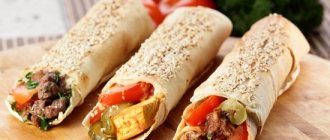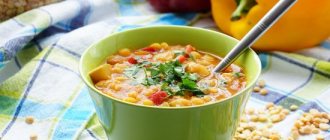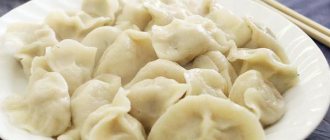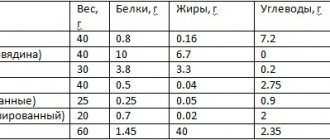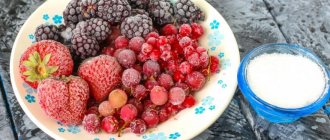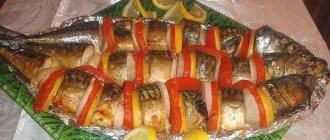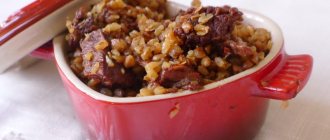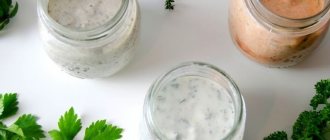Chemical composition
The chemical composition of rabbit meat can be characterized as follows: a lot of protein (20-22%), little fat (10-11%), moderate content of purine bases and cholesterol. Rabbit meat is tender because it contains little connective tissue fiber. Thanks to this, it cooks quickly and is easy to chew.
Rabbit meat proteins contain nineteen amino acids, including all essential ones (indispensable for humans).
Essential amino acids
| Name | Content per 100 g, grams |
| Arginine | 1,5 |
| Valin | 1,1 |
| Histidine | 0,6 |
| Isoleucine | 0,9 |
| Leucine | 1,8 |
| Lysine | 2,2 |
| Methionine | 0,5 |
| Threonine | 0,9 |
| Tryptophan | 0,4 |
| Phenylalanine | 0,5 |
Of the essential amino acids, 100 g of this meat contains a lot of tryptophan (50% of the daily requirement), valine, isoleucine (45% each), leucine (40%), histidine and methionine (30% each).
Rabbit meat fats are represented by both saturated and unsaturated fatty acids (FA), which is a rare phenomenon for animal fat.
Composition of fats
| Name | Content per 100 g, grams |
| Saturated fatty acids | 4,9 |
| Monounsaturated fatty acids | 4,5 |
| Omega-3 | 0,4 |
| Omega-6 | 2,7 |
| Polyunsaturated fatty acids (except omega) | 0,8 |
| Cholesterol | 0,025-0,04 |
The ratio of saturated and unsaturated fatty acids in rabbit meat is almost ideal: it is 1:2. This proportion keeps fatty acids in a liquid state, which has a good effect on lipid metabolism in the body. Rabbit fat contains a lot of lecithin, a complex of phosphatides that exhibits an anti-cholesterol effect.
There are practically no carbohydrates in this meat product, so they do not play a biological role.
Among the vitamins in rabbit meat, vitamin B12 (140% of the daily requirement), nicotinic acid (up to 60%), pyridoxine and choline (25% each) are of great importance.
Vitamins and vitamin-like compounds
| Name | Content per 100 g, milligrams |
| Provitamin A (carotene) | 0,1 |
| Vitamin B1 (thiamine) | 0,12 |
| Vitamin B2 (riboflavin) | 0,18 |
| Vitamin B4 (choline) | 116,0 |
| Vitamin B6 (pyridoxine) | 0,5 |
| Vitamin B9 (folic acid) | 0,008 |
| Vitamin B12 (cyanocobalamin) | 0,0043 |
| Vitamin PP (nicotinic acid) | 12,0 |
| Vitamin C (ascorbic acid) | 0,8 |
| Vitamin E (tocopherol) | 0,5 |
The mineral composition of rabbit meat is also very rich: it contains many macro- and microelements in quantities significant for the human body.
The most important minerals are cobalt (160% of the daily requirement), sulfur and phosphorus (23-24% each), zinc and chromium (up to 20%), potassium and copper (about 15%). Mineral content
| Name | Content per 100 g, milligrams |
| Potassium | 340,0 |
| Sulfur | 225,0 |
| Phosphorus | 190,0 |
| Chlorine | 80,0 |
| Sodium | 55,0-59,0 |
| Calcium | 20,0 |
| Magnesium | 25,0 |
| Iron | 3,3-3,5 |
| Zinc | 2,3 |
| Cobalt | 0,162 |
| Fluorine | 0,075 |
| Manganese | 0,013 |
| Copper | 0,013 |
| Chromium | 0,009 |
| Molybdenum | 0,005 |
| Iodine | 0,005 |
Rabbit meat is a low-calorie animal product: its calorie content is about 180 kcal per 100 g.
Beneficial features
Tasty, low-calorie and easily digestible rabbit meat has many beneficial effects on most organs and systems of the human body.
When regularly present in the diet, rabbit meat affects the cardiovascular and hematopoietic systems:
- reduces the concentration of cholesterol in the blood;
- improves vascular elasticity;
- dilates peripheral blood vessels;
- increases the tone of the venous walls;
- helps reduce blood pressure;
- reduces the permeability of vascular walls;
- restores damaged intima of arteries and veins;
- normalizes blood viscosity;
- improves myocardial oxygenation;
- helps increase hemoglobin levels.
Rabbit meat has a stimulating effect on the digestive organs:
- accelerates the restoration of cells in the mucous membranes of the digestive tract;
- promotes the secretion of pancreatic juice;
- reduces the viscosity of bile, thereby preventing congestion in the bile ducts and bladder;
- increases bile secretion;
- normalizes intestinal motility.
Rabbit meat contains much fewer allergens than other types of meat, so it can be consumed by people with multiple food allergies.
Proteins, fatty acids, vitamins and minerals of rabbit meat are beneficial:
- children;
- pregnant women;
- women who are breastfeeding;
- elderly people and old people;
- convalescent;
- during severe and long-term illnesses;
- with weakened immunity.
The low calorie content of rabbit meat allows it to be included in the diet of obese people and those on diets.
Harmful properties
It is rare to be allergic to rabbit meat, but some people do develop it. If you have an allergic reaction to rabbit meat, its consumption is prohibited.
In terms of the content of purine bases, rabbit meat is the “anti-leader” among all types of meat: it contains the smallest amount of them - 38-40 mg of purines per 100 g. For comparison, there are 48 mg in 100 g of veal, and up to 70 mg in 100 g of pork. . Therefore, rabbit meat is the type of meat that is allowed in small quantities for patients with gout, but not more than three to four times a month.
Due to the purine content, children with hyperexcitability of the nervous system and those with a neuro-arthritic type of constitution (diathesis) should limit the amount of rabbit meat consumed.
The consumption of rabbit meat by patients with psoriatic dermatitis should be limited to two to three meals per week. At the same time, it must be cooked without fat, that is, by boiling or steaming.
Boiled
It is recommended to make soups from rabbit meat. Not only the pulp is used here; even the breast, which contains small bones in large quantities, is useful in soups. Many people like to eat this kind of meat with bones. This is where the special taste comes through.
Many restaurants serve some of the best soups. It is recommended not only to healthy people, but also to sick people. The preparation process is simple:
- Divide the rabbit carcass into pieces of approximately 40...70 g.
- Cook for about one hour, add salt at the end of cooking.
- Remove the cooked meat from the broth and let it drain, then cool.
- Now it's time for the vegetables. Grind the carrots in a blender, then chop the onion.
- Place the vegetables in the broth and cook for about 10 minutes.
- To make the soup rich, add washed rice. The rice cooking process takes approximately 15 minutes.
- Green peas are added, and then celery. Cooking these ingredients takes about two minutes.
- When serving the dish, pieces of boiled rabbit meat are added to the soup.
This soup is recommended for people suffering from gastritis, stomach and duodenal ulcers, all the ingredients in it will be easily absorbed by the human body.
When preparing for cooking you need to have:
- rabbit meat about 300±50 g;
- small carrots, approximately 150...170 g;
- onion weighing about 70 g;
- washed rice 65...70 g (about one third of a glass);
- celery - one plant about 10 g;
- canned green peas about 200 ml;
- you can add parsley and dill 10 g each.
The soup is boiled in 2 liters of water.
The resulting dish per 100 g will have a calorie content of 32.8 ± 0.1 kcal. The composition will include:
- proteins – about 2.9±0.1 g;
- fats – no more than 0.9±0.05 g;
- carbohydrates – just over 3.4±0.05 g.
Application in medicine
Considering the beneficial properties that rabbit meat exhibits on the human body, it is recommended to include it in the diet for various diseases:
- circulatory system (atherosclerosis, post-infarction and post-stroke conditions, arterial hypertension, coronary heart disease);
- digestive organs (gastritis, peptic ulcer, biliary dyskinesia, hepatitis, fatty liver, pancreatitis, colitis);
- metabolism (obesity, diabetes, protein deficiency);
- blood system (anemia, weakened immunity, pancytopenia);
- allergies.
It is useful to consume this meat product for patients suffering from dermatological diseases. Substances contained in rabbit meat accelerate the healing of wounds on the skin and improve its condition.
In order for rabbit meat to be beneficial and not show harmful properties in various diseases in humans, it must be prepared in gentle ways: boiling, steaming, stewing. Frying and baking rabbit meat increases its calorie content, increases the content of purine bases, destroys amino acids and vitamins, and oxidizes beneficial fatty acids.
Outdoor use
Rabbit fat is used as a remedy for external use for various skin diseases (trophic ulcers, psoriasis, eczema, dry calluses, wounds, burns).
It is also used to enhance hair growth by mixing it with butter and honey in equal proportions and adding a clove of garlic. The freshly prepared product must be rubbed into the scalp. 60 minutes after application, rinse with warm water. After several procedures, the hair becomes stronger and begins to grow faster.
Braised rabbit in white wine
Recipe ingredients:
Cooking process:
The stewed rabbit, whose calorie content is 147 kcal, must be served hot. As a side dish, you can use baked potatoes or light vegetable salads.
How to select and store
When choosing a rabbit carcass on the market, you need to follow simple recommendations:
- you need to refuse to buy this product in spontaneous markets where there is no sanitary and veterinary laboratory and conditions for the sale of chilled meat;
- you should check for the presence of a veterinary stamp;
- carcass weight should not be less than 1100 g;
- the carcass must be completely bled;
- the surface of the meat should be moderately moist and elastic;
- There should be no foreign odors from the meat, except for the slight smell of fresh meat.
Fresh meat cannot be used for cooking: it must be ripe. To be sure of the ripeness of meat, after purchase it must rest for at least 8 hours in the refrigerator.
The shelf life of rabbit meat depends on storage conditions and is:
- in the freshness zone of the refrigerator at a temperature from 0 to +2°C - up to five days;
- in the refrigerator at a temperature from +2°C to +6°C - up to two days;
- in the freezer at a temperature of -18°C - 6 months;
- in the freezer in vacuum packaging at a temperature of -18°C - 10 months.
Rabbit stewed in sour cream: recipe
The recipe for stewed rabbit has long been popular in Russian cuisine, although it is not a traditional dish. Rabbit stewed in sour cream, the recipe for which is posted below, is a very tasty dish that is also suitable for women who are losing weight, since its calorie content is not very high. The calorie content of stewed rabbit depends on the method of preparation: naturally, in sour cream it turns out to be more nutritious, but its meat also becomes soft and tender.
Ingredients for preparing rabbit stewed in sour cream according to the recipe:
- Rabbit - 1 pc.
- Carrots - 2 pcs.
- Onion - 1 pc.
- Garlic - 4 teeth.
- Vegetable oil - 4 tbsp.
- Sour cream – 370 ml
- Chicken broth - 1.5 tbsp.
- Olive oil - 3 tbsp.
- Bay leaf - 2 pcs.
- Curry - 2 tsp.
- Ground black pepper, red pepper flakes and salt - to taste.
Step-by-step recipe for stewed rabbit
1) Wash the rabbit carcass, cut it up and dry it with a paper towel.
2) Prepare the marinade for rabbit stewed in sour cream according to the recipe: peel and pass the garlic through a press, mix it with olive oil, salt, black and red pepper.
3) Rub the mixture onto the pieces of meat and leave it to marinate a little.
Rub the meat with marinade
4) Peel the onions and carrots, cut them into half rings to prepare the rabbit stewed in sour cream according to the recipe.
5) Heat vegetable oil in a frying pan and fry the meat in it on both sides until golden brown.
6) Add vegetables to the rabbit and fry them until soft.
Add carrots and onions to the meat
7) Pour the broth over the vegetables and meat, bring it to a boil and simmer the rabbit until cooked (until the meat separates from the bone) for about an hour.
 Add curry and sour cream to the stewed rabbit according to the recipe.
Add curry and sour cream to the stewed rabbit according to the recipe.
Add curry and sour cream to the rabbit
9) Mix the contents of the pan and cook it over low heat for a couple more minutes. The rabbit in sour cream is ready - bon appetit!
- The calorie content of stewed rabbit depends on the fat content of the sour cream used - we used low-fat sour cream (15%).
- According to the recipe, the stewed rabbit can also be prepared with vegetable broth or water. The calorie content of the stewed rabbit will be lower, but the taste may suffer.
- Instead of 4 tablespoons of vegetable oil, when preparing a stewed rabbit recipe, you can use 60 grams of butter.
Use in cooking
Rabbit meat is a universal meat product in its preparation method. The rabbit is boiled, steamed, grilled, baked, fried, stewed, smoked.
Before heat treatment, rabbit meat is often marinated in sour cream, whey, vinegar, and white wine. The marinade prevents the meat from drying out during frying or baking. It goes well with seasonings:
- black pepper;
- oregano;
- bay leaf;
- thyme;
- celery;
- cloves;
- cinnamon;
- basil;
- parsley;
- dill;
- garlic;
- juniper.
Due to the fact that it contains a little of its own fat, rabbit meat can be prepared as both a dietary and high-calorie dish.
Diet bunny
To prepare it you need to take: half a rabbit carcass (preferably the front one), celery root, one carrot, two onions, salt and bay leaf. Small pieces of meat need to be poured with water, boiled over high heat and boiled until a large amount of foam appears. After this, drain all the liquid and wash the pan. Place the washed meat back into the pan, add boiling water, add salt and bring to a boil over low heat. Pour peeled and cut into strips vegetables into the boiling broth. Simmer over low heat for at least an hour. Before turning off, add bay leaf. You can serve with blanched broccoli or asparagus.
Non-diet rabbit in sour cream sauce
Best materials of the month
- Coronaviruses: SARS-CoV-2 (COVID-19)
- Antibiotics for the prevention and treatment of COVID-19: how effective are they?
- The most common "office" diseases
- Does vodka kill coronavirus?
- How to stay alive on our roads?
For this dish you will need: 0.5 kg of rabbit, a glass of sour cream and water, an onion, 2 tablespoons of butter, salt to taste, seasonings (turmeric, paprika, Italian herbs, white pepper). In a hot frying pan greased with butter, brown the rabbit pieces. Saute the onion, peeled and cut into rings or half rings, in butter in a separate frying pan until transparent. Mix sour cream with water, salt and spices to taste. Place the fried rabbit and onion in a saucepan, pour in the prepared sour cream filling. Simmer the dish over low heat for 1.5-2 hours (depending on the age of the rabbit).
Rabbit stewed in sour cream
- Cut the rabbit into portions, rinse, rub with salt and pepper and leave for 30 minutes.
- Then fry over high heat in sunflower oil.
- In the same oil, fry onion half rings and chopped carrots.
- Place meat in a bowl, fried onions and carrots on top.
- Add sour cream, flour, pour water.
- Add salt and throw in the bay leaf.
- Simmer for 1.5-2 hours on low heat.
Ingredients for the recipe “Rabbit stewed in sour cream”:
- Rabbit - 1300 gr.
- Onions - 100 gr.
- Carrots - 1 pc.
- Sunflower oil - 50 gr.
- Sour cream - 150 gr.
- Wheat flour - 30 gr.
- Salt - 2 gr.
- Black pepper - 2 gr.
- Water - 600 gr.
- Bay leaf - 2 pcs.
Nutritional value of the dish “Rabbit stewed in sour cream” (per 100 grams):
Calories: 122.2 kcal.
This is a custom recipe, so there may be errors and typos. If you find them, please write them in the comments below the recipe and we will correct them.
Step-by-step recipes with photos from our website are in the “Recipes” section.
Liked? Rate it and save it on your social network page!
